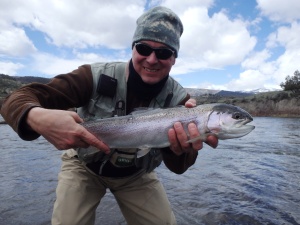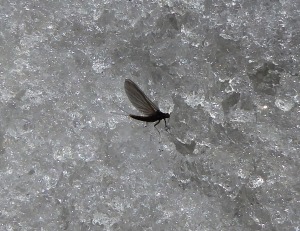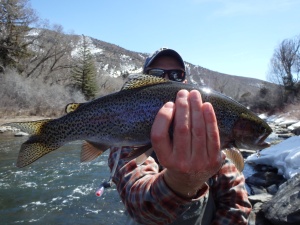Archive for the ‘#eagle river’ Tag
Feel Your Way…….
Hidy Ho Good Neighbors,
So, have you tried Euro style nymphing yet? I know, sounds funny coming from a guy that wrote a book about the systematic approach to nymphing, but I have done a fair amount of this technique over the last couple of years. Even have my clients working a modified euro system on pretty much every guide trip.
Now, I’m no expert on euro style, but I appear to be qualified enough to talk about it because my clients catch plenty of fish, even on the first time out, using my quirky method. I tagged my method “eurorado nymphing” because it includes Colorado nymphing methods coupled with euro-style principles. I’ve included a section in my latest book, Hidden in Plain View, that goes into greater depth on what I do.

A good stocking stuffer
Suspended nymphing under an indicator still has a place in my arsenal as it can create longer more consistent drifts, gives you the ability to work water that is more than a couple rod lengths away, and gives you the ability to see fish eats thru the indicator. However, the ability to work the upper half of a drift effectively while dialing in drift speeds is a bit tougher under an indicator. Think back to the last time you nymph fished, how many fish did you catch upstream of the halfway point of your drift? Exactly, it’s hard to recall because it just doesn’t happen as often as the fish you catch from the middle to end of the nymph drift. That’s because that is when most anglers have the depth and speed finally perfect.
Eurorado style, on the other hand, allows you to work the upper part of the drift well. It allows you to feel working over obstructions, shelves and bars. And, you catch the majority of the fish above the middle point of your drift, because you get the bugs down quickly, and dial in depth and speed quickly after your bugs hit the water. Each method has its merits, but like I always say, the more versatile an angler you are, the more you’ll enjoy the sport.
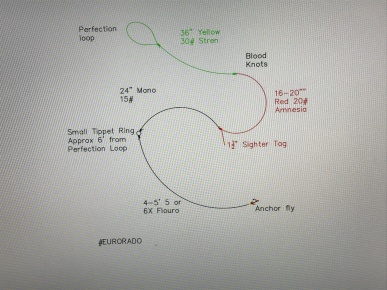
Customize as needed
Some days Eurorado nymphing is like a vacuum, picking up fish in a river where suspended nymphing wouldn’t be able to and it’s relatively easy to rig and learn. Again, I’m no expert, but there are many videos available that can get you started. As for gear, I run a 10’6” 3 weight Master Nymph Bellator fly rod with a matching Lamson Liquid reel. This rig is balanced and light weight with incredible accuracy and fish fighting capabilities. I also employ a sighter-leader of my design and use bugs of my design.
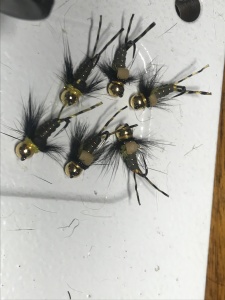
A gaggle of Booby Traps
The sighter-leader and flies used is where I put the “rado” in this rig, because it smacks of Colorado nymphing. Most Euro-style leaders are around twenty feet (and longer) lengths, whereas my leader is around eleven feet long. It is comprised of several different sections of monofilament, fluorocarbon, and amnesia lines, with a sighter tag and tippet ring thrown in for a cause (see pic). As for my bugs, I run a weighted Booby Trap, as my anchor, and run in-line off of that. So, off the bend of the Booby Trap, I run tippet to a DP643 which is an unweighted soft hackle, and off of that bend I run a Butt Crack Baetis (unweighted) in the appropriate size and color. I’m sure you can see the indicator nymphing influence here.
This rig has served me and my clients well over the last couple of years on the Eagle River, and it can easily be customized to your favorite water with a little thought and tinkering. I continue to learn a bit more each time my boots get wet, but I am sold on this technique. I really enjoy the simplicity, ability to feel your way along a river bottom, and the consistency to get depths and speeds dialed in quickly on every drift.
That’s my story and I’m sticking to it…….Fear No Water!
Happy Holidays!
Hidy Ho Good Neighbors,
Once again, the speaking circuit is up and running. Just got back from Atlanta, and getting ready to head to Texas for the GRTU Troutfest. In between, I will have a couple chances to get on the water, tie a few bugs, and tighten up my speaking game. It’s a whole different world this time of year.
Buzzing around the country talking with so many anglers is quite humbling and extra enjoyable. I sat with Lincoln Westby (look him up if you don’t know who he is) for two full days last week at the Atlanta show, just picking his brain. At seventy plus years of age he is still incredibly passionate about this sport. I was humbled and truly thankful for that opportunity, plus I picked up more than a few tips. I bump into all kinds of people that teach me loads simply by the questions they ask. Many times, I have to stop and think on their question, which forces me to make ask them questions, make choices, clarify, or quantify a stance on a particular subject. Doing this tends to sharpen ones focus, and steel ones opinions.
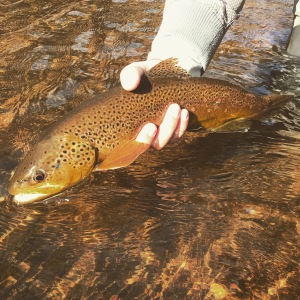
@rodcuffs releasing a South Platte Brownie
Once I begin to sharpen focus on a subject then I begin to dig into my reasoning for believing one way or another, and every now and then, I change my stance on a previously held thought. Sometimes, however, I stop, cock my head to one side and think, “Nope, not going to believe that.”
At a show last year, I was walking by the casting pool as someone was presenting to a group of anglers. This presenter was talking about setting the hook techniques, and had the fly rod pointing down to the opposite end of the pool as the point was made. With line out in the pool, and a large management loop formed from the index finger on the cork, this person proceeded to explain a dry fly set. “Reach up here with your left hand, grab the fly line up here above the cork, and pull hard to the side as fast as possible.” I stopped in mid stride at the edge of the pool just to confirm what I thought I heard. Yup, that’s what I heard.
So, in front of your management loop, you reach up with your off-hand grabbing the fly line and pulling to the side for the set. This alignment renders your loop worthless. What if you happen to hook the fish? Then, you’d have to take the line in your off hand and put it back under your index finger on the cork, just to begin to fight the fish. This is as hard to explain as it is to be believe. So, imagine you’re holding the fly rod in your right hand, and the management loop is created between your index finger on the cork and the fly reel. See it? Now, a fish eats so you need to set. Take your left hand and reach above your cork hand (toward the fly rod tip), and grab the fly line between the first line guide and the cork, above your hand. Pull it tight, out to the side, quickly.
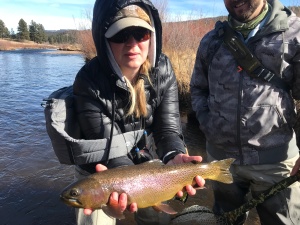
Nice winter fish for this sweet lady
I don’t get it. Usually when I hear something like that I can find some merit, or reasoning. I am still stumped many months after hearing this, and have shared this story with many in hopes someone could enlighten me. Not being a jerk here, but honestly trying to figure out what I am missing, because I just might learn something. Shoot me a note with any theories. You can’t ask a stupid question here, or give a stupid response, it’s all about learning.
The Eagle River has some shelf ice up high, and downstream you’ll find smaller amounts. The lower river has been checking in at about 38 degrees at ten in the morning, and warms up to about 41 degree on full sun days. Midges are coming off, and I (and the fish) are already beginning to look for Blue-Winged Olives. Not a bad idea to throw a pink San Juan, Black Soft Hackled PT, and a Buttcrack Baetis in that order, if you’re so inclined. Other combinations will work equally as well as long as depth and speed are dialed in. Go low and slow.
The latest book (Hidden in Plain View) is still doing well. Thanks again everyone.
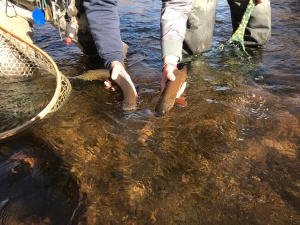
Sweet release times two….
Fear No Water!
Duane
Hidy Ho Good Neighbors!
Folks insinuate all of the time that as a fly fishing guide, all I do is stand in the water and bark orders. Couldn’t be further from the truth. I often will count my steps on my phone app, and I’m regularly in the six mile range when I guide six continuous hours or more. More often than that, by 9am in the morning, I’ve already sweated through my hat. Not all days are like that but those of us that wade guide hustle a bit more than folks think.
Guiding is a lifestyle and I wouldn’t have it any other way. I enjoy zipping back and forth between clients, landing fish, teaching, and yes, even untangling leader and tippet explosions. I enjoy the outdoors, sights and sounds, driving to the river with expectations, tying bugs the night before, and battling Mother Nature everyday anew. I enjoy the grind, dipping my hat in the drink because it’s so damn hot, dodging thunder storms, sunscreen burning my eyes, freezing my finger tips, the physical exertion, and the challenge. I like sitting on my tailgate behind the fly shop, guzzling a well-earned beer and smoking my pipe at the end of a long day on the river.
Couple years ago in July, and I remember it as if it were yesterday, I began the day with 3 clients from Ohio. We fished near Wolcott on the Eagle River for about six hours, and had a pretty successful outing with many fish hitting the bottom of the net. On my way back to the shop, toting my clients, I get a call from one of our managers. “Hey D, this is so-and-so, got one of your regulars in the shop, he just hit town unexpectantly and wants to know if you can give him four hours this afternoon on the river.” “Ah, sure” I reply, trying to not get my clients involved in the conversation. “Good, ok”, says my manager and he squeezes in the next words without taking a breath, “Can you hoof it?” “He has late dinner plans for tonight.” “I’m about twenty minutes out”, I say.
I love doing “doubles”, but I’m rarely prepared for that call. If I know they’re booked, it’s much easier to transition from trip to trip than finding out last minute. I had plans, like a nap, maybe go fish a bit, or hang out with my colleagues. No worries, I’ll make this happen, but I have a routine that I like to follow. I like to re-rig all of my rigs with fresh bugs and tippet the night before my next day trip. I like to go through a physical and mental checklist, I hate to be hurried prior to a trip, and I like to be at least an hour early before a guide trip. In this circumstance, I had none of those. Not only am I a creature of habit, but I’m a bit superstitious…..I have learned to not let this kind of stuff bump me off my game.
I dropped my clients off at the municipal lot down the street from the shop. Knowing my client was waiting for me at the shop, I decided to take a five minute break right where I was, and try to find something to eat and drink. My cooler revealed I had 4 waters left, one warm beer,and I was out of snacks. That’s the other thing I was going to do, hit the supermarket for drinks and goodies. Oh well, I needed to save the water for sure, but I’m thirsty as heck, “Guess I’ll pound the warm beer”, I thought out loud. I dropped the tailgate and took a good guzzle of warm suds. Just then it dawned on me, yesterday I bought a bagel at the supermarket before my trip, “Where did I leave that?”. I started rummaging through the backseat looking for that blueberry bagel. I reached under the front seat and found pay dirt. Yes, warm beer and a blueberry bagel for lunch! One of the best lunches I ever had.
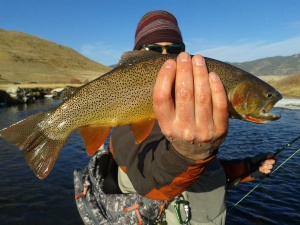
Winter spoils
I went out with my client that afternoon and we threw dry flies for about four hours. Can’t get much better than that. No, guiding is not the toughest job in the world, but it does have its challenges. Now when someone asks me how my day went, I usually reply, “I was outstanding in the river.” Ya, I know, guide humor ain’t much, but it’s better than a beer and a bagel.
The Eagle River has been fishing well this winter. Little shelf ice, clear water and active fish has made for a good start to 2018. We desperately need snow though, so if you live within 1000 miles of us, send some our way.

Butt Crack Midge for winter.
Humbled to say the book is doing well. Thanks to all of you who has purchased a copy of Hidden in Plain View. Review it on Amazon if you’re so inclined, or shoot me a note letting me know your thoughts. Thanks again!
Fear No Water!!!

Thank you!
Hidy Ho Good Neighbors!
“We had our July in August” That’s what I told one of our young guns the other day before we headed to different spots on the same river. What an odd season it has been. Usually, I can somewhat predict flows and clarity pre, during, and post run-off, but this year, like last, has been confusing to say the least. July fished like August for the second straight year with somewhat picky fish, hot air and water temps, and a high sky. We were all scratching our heads as to what was going on. “Then the rains came……..”
We endured several run-offs this year. Gone are the days when you could bank on a steady, concerted melt and drain. It would start, then stop, then start again. Seems like it started in April and was done this year in late July, statistics prove that out. That lack of consistency really makes you scratch your head at times as to where the fish are holding and why. They aren’t following the typical patterns to movement because the typical patterns no longer exist. The flows this year averaged about twenty percent higher than norm until just a few weeks ago, so the fish didn’t spread out in earnest until late July. Only then did we start consistently catching fish in the faster and shallower riffles.

Fish ate a dropper in the mini rig for Thomas.
But wait there’s more! Typically, after the 4th of July, all I throw is the Mini Rig. This rig allows me to cover water from 6” to nearly 4 feet deep fairly effectively. It’s all I ever needed after the fourth all the way into late October. This year, because of flows, torrential afternoon rains, cold water temps, and funky fish holds, I found myself using the nymph rig more and more, while the Mini Rig sat idle on the bank. Gotta fish ‘em where they’re feeding consistently, so nymphing ruled the day until about two weeks ago.

One of the last nymphed fish this season.
Now the flows are perfect, the water is gin clear, and small quills and tricos are coming off. It’s been a Mini Rig domination the last two weeks, backed up by double dry rigs and an occasional streamer or nymphing rake. Back right where she should be, even though temps hit the mid-thirties a couple mornings last week. I’ll take it, means fall is on the way, big orange sedges, trico spinner falls, pseudo-baetis, and hoppers on the edges. Plenty of water this year, so I guess it’s ok to have that many run-offs after all. Mama Nature knows what she’s doing.

Eric with a fish that ate a dry. Cherry series 8′ 4wt- 8 Rivers Fly Rods
Just a couple quick notes:
I am building next year’s speaking schedule, so if you know of any club or organization looking for a fly fishing speaker feel free to contact me.
Hidden In Plain View is going well. I am knee deep into the photo and illustration portion, and loving every minute of it. Looks like a mid November completion date.
And lastly,
The Butt Crack baetis made it into the Montana Fly Catalog. It’ll be available, along with the Butt Crack Midge, early next spring.

Butt Crack baetis- My go to fly most of the year…..Coming to a fly shop near you!
Fear No Water!
Hidy Ho Good Neighbors!
Added a new video at: https://youtu.be/h_8BmcfsYnQ

Obligatory grip and grin…
This one deals with fishing those juicy shelves you find in every river. Not all shelves look the same. Most are very easy to locate at the lateral top of a run, some are hidden within the run and some run longitudinally with the run. If you look closely at the video thru the link I provided, you will see a fast riffle dumping over the shelf. Look closer and you will see “sleeper seams” within the run as it dumps over the shelf. Sleeper seams show nearly imperceptible areas where obstructions gently slow the river flow. Almost a sure thing that you’ll find feeding fish holding in those sleepers, and the adjoining seams, but you’ve really got to stop and look closely.
The trick is to cast up onto the fast water to place your bugs above the shelf and put them in perfect position as the water slows and drops onto the shelf. If fish are up there, they are there to eat. Make sure you’re mended up, anticipating the next mend, and primed to set quickly. Adjust your rig longer and heavier than you think you’ll need because you want your flies to follow the same path as the naturals. If you’re too light or too short, your flies will rarely drop into the proper column as the fish are below the fast water, because they are sitting in the slower flows down on the shelf. Once you really concentrate on mastering a few shelves, the formula becomes easy to figure.
Sometimes you’ll see where a lateral, across the river shelf, and a longitudinal, with the river shelf connect. That situation can be pure magic as it provides multiple areas where food and fish will collide. That’s the crux of the Fly Fishing Formula. You want the fish to either eat or get out of the way. Opportunistic feeding fish will move distances to eat, selectively feeding fish will either eat or sway out of the way. They are more prone to eat if your drift is perfect and your flies are close to the naturals in size and color. Make the fish decide.
Enjoy the video. Go work a shelf as soon as possible and get back to me!
Fear No Water
Alaska. Unless you’ve been there you just can’t comprehend the beauty. Now, I live in arguably one of the most beautiful places on the planet, Colorado. But, Colorado is no match for the unbridled beauty of Alaska. It’s huge untamed landscape that thrusts up and out of the ocean, coupled with the colors, and vastness is not something that pictures can capture.

Unbridled beauty….
I was afforded the opportunity to fly fish Alaska because a couple of my long-time clients wanted to give it a whirl. Minturn Anglers offers a wonderful package for fly fishing for Steelheads, Silvers, Huge Rainbows and all of the Dolly Vardens you can catch. Next year, rumor has it, we are expanding our trip packages to cover five weeks. These are one week packages, and not only is the fishing stellar, but the accommodations are incredible. If you’re ever interested in a trip like this don’t hesitate to contact me. I still have an Alaska blush.
The gear we took was as important as the plane tickets themselves. Keeping everything dry was the top priority on my list. Aside from a good pair of waders and a raincoat, I needed something that would keep my other gear dry. Whether we floated or waded, I needed to be able to carry important items on my back the entire time. A place to carry a lunch, provide fire starter, a dry set of clothes, and any other stuff, in a dry venue were paramount. I settled on the Umqua Tongass backpack.
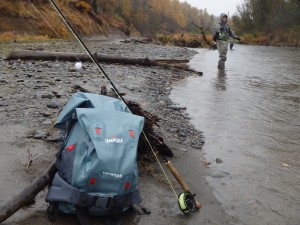
The pack…..
This 30 liter backpack, complete with padded shoulder and waist strap was more than up to the challenge. It has two water proof compartments that employ a simple roll-top closing system. The closing system was a huge bonus. Not only did it keep the pack water-tight, but it is very easy to quickly access the stuff you carry inside. It also has a hanging interior pocket that I quickly figured out carried my cell phone safely.
I really liked the exterior pockets (6) and used the two on each side for anything from rod tubes to adult beverage carriers. The pack has “cinch straps” to ensure everything rides compactly, balanced, and comfortably. Although we hiked through some pretty nasty willows, I never had the pack hang up because of the way it hugs your back.
I used my pack as carry-on and it fit nicely into the overhead compartments. One little trick I used was to fold the waist straps back over the pack itself, and hooked them in place. This way the pack had zero external straps to hang up while transporting, going through the xray machines, or riding in the trunk of the rental car. When fishing, the entire system of adjustable straps made for comfortable days. No shoulder or hip pinch was experienced at all, and the pack stayed put even while spey casting.

Cold steel….
I strongly recommend this pack, and come fish Alaska while you’re at it.
Fear No Water,
Duane
p.s. Black Friday’s coming up, don’t forget the Fly Fishers Playbook 2nd Edition for your favorite angler!
Hidy Ho Good Neighbors,
One of the perks from guiding is the chance to watch a lot of folks catch and land fish. Explaining to someone that has never fought nor landed a fish properly using a fly rod is like explaining a video game over their shoulder in the heat of the battle. Moves one makes intuitively or by “feel” are born out of experience of landing many fish. As guides, we can flatten that learning curve in a half day provided the fish are eating regularly, and by teaching a few basic principles.
First off, it’s called “angling” for a reason. Landing fish is as much about angles and physics as any part of fly fishing. Your fly rod is a lever (class 3 I think), and also acts as a shock absorb-er. The fly reel not only stores line, but can become a smooth fish slowing drag device. For now, let’s just concentrate on the fly rod angles.
After hook-up, get the fish on the reel as quickly as possible. For those folks that like to “strip” fish in, no worries, I teach folks to get on the reel because it gives them one less thing to think about as they begin to learn proper landing techniques. Once on the reel, get your rod hand thumb as high as your hat brim. At this point, your rod elbow should be pointing toward the fish. Now the fun begins. I always tell folks that “now you’re in a relationship with the fish”. It’s like a dance, move-counter move. Get caught standing still, and you’re date will be gone…..
If the fish “zigs”, you “zag”, keeping constant lateral pressure with the angles of the fly rod. It’s ok, when safe, to move up and down the bank to keep those working angles. As you reel and the fish gets closer, the angle of pressure on the fish should begin to be “over” the fish. In other words, lateral pressure begins to become upward/lateral pressure. This is a critical part of the land job, because as you transition back and forth between lateral and upward pressure, it’s easy to lose proper angles AND put way too much pressure on the fish.
This is what I really want to point out to folks. Imagine that you’re walking your dog. You are not pulling your dog as you control it, you are simply limiting, with positive pressure, where it can go. Think of it this way, if your dog’s leash were to snap during a walk, your leash arm shouldn’t go swinging violently the other direction. This is what I see all the time. A fish will come unbuttoned, and the anglers rod arm goes flying the opposite direction. Improper angles and pressure? Yup.
In the far left picture, I am keeping lateral and up pressure during the transition. If that fish came loose the fly rod would react more “up” than away, and toward the bank behind me. The goal is to make that reaction as minimal as possible. That would mean you are using the fly rod angles and pressures perfectly. Look at the picture on the right. This was on a guide trip, and this client had rarely had a fly rod in hand. He was ready to land his own fish by the end of the day. If the fish were to come unbuttoned at the instant the picture was snapped, his reel and hand, if the correct angles and pressure were installed, would move to the red square position. If improper angles and pressures were installed, the the reel would move to the end of the blue line violently. It’s observable on the anglers part, and easily correctable.
Once you get into proper fish-fighting position, the fly rod becomes Harry Potter’s wand. Move it side to side, low to high, near to far. Whatever it takes to keep constant proper pressures. I’ve a “Landing Fish” video on Youtube somewhere, and a link in my archives (somewhere).
As always, feel free to shoot me questions, share this blog link, or contact me if you want to fish.
Fear No Water,
Duane
Guide, Minturn Anglers

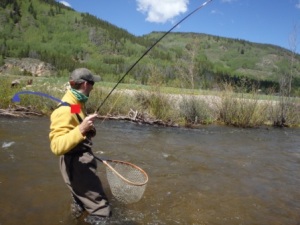
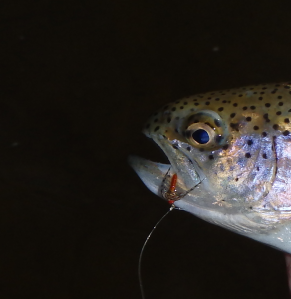
I can remember it like it was yesterday. Ten years old, cut-off jeans, Chuck Taylor Hi-tops, and a red t-shirt with one of those little pockets. I was standing knee deep in the Yellowstone river, fiberglass rod, Martin “electric reel”, hand-tied leaders, and I was swinging wet flies to big Cutthroats. Rock and Roll.
Nowadays, most folks have forgotten wet flies in favor of their favorite pattern nymphs or articulated streamers. I’ve no problem with those patterns, but I sure do like throwing the old stuff. They still work.
Got back into soft-hackles more than a couple years ago, and most days you will find a soft-hackled pheasant tail in my rig somewhere. Lately, since I’ve been guiding on the Eagle River, I’ve gotten back into the “partridge series” because of the crazy amounts of caddis in that river.
I really like tying into fish with the Partridge and Orange, Partridge and Green, Partridge and Peacock, and Crackleback patterns I fished as a kid. They really mimic caddis pupa and can be dead drifted and swung very effectively. Because of the nature of caddis pupa emergence, these bugs are perfectly suited for the job. My clients love it when a fish eats hard at the end of the drift in the swing phase. The fish pictured ate the Partridge and Orange hard on the swing.
Typically, the bugs are the last or point fly in my 3 bug nymph rig. I do this to accentuate the movement (like roller derby whip for us old folks), and the farther the bug is away from the weight the higher in the column she’ll travel. There are times when I place the bug in the middle position of the rig, and I’ll tie it eye-to-eye to flatten the profile. (a search thru the archives will show eye-to-eye connections, rigs, etc.)
One other trick you can employ is to get upstream of fish feeding on caddis pupa or adults, and strip out enough line to set you up for a swing directly in front of those fish. Employ a classic nymph drift by casting roughly 45 degrees upstream, let the bugs drift drag free for three quarters of the drift, stop your fly rod movement at the three quarter mark, and allow your flies to swing up through the columns and across in front of the fish. Deadly.
Sometimes newer isn’t better, only newer. Give those old patterns a try sometimes, just like that old time rock and roll.
See if you can identify the bugs below……….One is different, but the same idea. Used it hundreds of times.
Fear No Water,
Duane
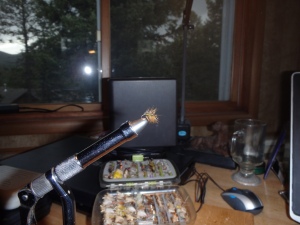
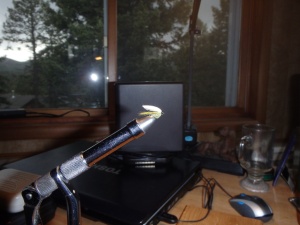
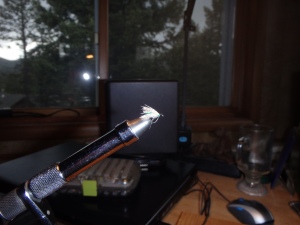
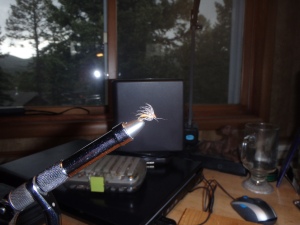
Hidy Ho Good Neighbors,
Been a while since I last posted. A lot going on, but that’s not really a good excuse. Truth is I’ve changed fly shops. Not that I didn’t absolutely respect my old fly shop, but I am the kind of person that enjoys a new challenge now and then. I now work for Minturn Anglers in Minturn Colorado. Unbelievable amount of water to guide, and quite frankly, I am being stretched to my limits. You know, I go all over the place giving presentations about fly fishing and because of the “new” water I’m fishing, it’s time for me to prove what I spout about technique is not just smoke.
More often than not, I am given a stretch to fish or someone recommends a stretch to fish, and off I go with clients to make it happen. Just last Sunday I was on Gore Creek as it flows thru Vail. Bob Streb and Joe gave me the boundaries using Google Maps, and as much info as they could. It was up to me to really dig into the how-to’s, what-to’s, and the when-to’s to get my folks on fish. Not ever stepping foot into water that you need to produce fish for folks is more than interesting. That’s a challenge, and I look forward to it!
I always tout the importance of historical, seasonal, and conditional data when it comes down to successfully fly fishing a river for the first time. I have found this idea to be the most important factor in getting clients on fish in unfamiliar waters. If you snoop thru the archives of this blog, you’ll find more info about the data I’m talking about. The techniques are roughly the same, I’m finding that the data is of the utmost importance.
Sure, I may run bugs a bit deeper, or the sizes may be different than what I’m used to, but the chance to pick peoples brains about how a river fishes, at various times of the year is HUGE! I’ve gone from tailwater to freestone fly fishing, if folks don’t think that’s a big shift, then they haven’t been paying attention. This challenge is exactly what I want and need. I am getting better as a guide, getting stretched, and I’m rejuvenated.
All this new information is going into journals and presentations to eventually become my next book project. I’m really excited to get that moving. Folks, all I’m really trying to say is get out there and stretch yourself as a person and an angler. Fish new water, see new sights, meet new people.
Below are some pictures of folks with nice fish from the Eagle River and Gore Creek……..
FEAR No Water!
Duane

